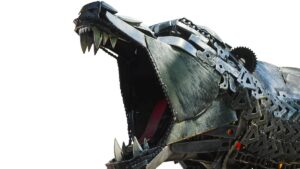Resources Top 5: The ASX’s traffic cops can’t stop a Cyclone

Cyclone continues to rage as iron ore junior moves higher. Pic: Getty Images
- Iron ore junior Cyclone Metals trades higher for second straight day with no news to report
- BPM wraps up drilling near 3Moz gold project
- Patriot up on copper samples
Your standout small cap resources stocks for Tuesday, December 17, 2024.
CYCLONE METALS (ASX:CLE)
(Up on no news)
As the ASX’s silly season approaches small cap stocks are flying left, right and centre, with a presumably trimmed ASX compliance team trying to do what it can to keep track of the changes.
For the second day in a row iron ore junior Cyclone Metals is up on what appears to be a wing and a prayer, CommSec showing $1.18m worth of shares have changed hands across 586 trades and close to 29 million flying shares that have sent its share price 21% higher to 4.5c.
It came after a similar run that prompted a price and volume query from the ASX, colloquially known as a speeding ticket.
Nothing to see here, CLE chair Tony Sage intimated, in a string of “no” responses to questions from the market umpire on whether it had any news to divulge.
The junior’s shares have more than doubled since it signed an MoU with Brazil’s Vale, one of the world’s largest iron ore producers, over a farm-in and potential JV at the Iron Bear project near Schefferville in Canada.
That 16.6Bt magnetite resource, which grades around 29.5% Fe, has been shown to be capable of upgrading to a direct reduction grade concentrate in excess of 71% Fe. That would put its potential product in league with the less than 10% of seaborne iron ore products capable of being used in the low emissions DRI process.
That would, in theory, draw a premium from customers, with Vale already one of the world’s few suppliers of commercial DR grade iron ore.
Investigations are ongoing elsewhere into a steelmaking process that would produce a similar product with 62% Fe Pilbara style hematite, with a pilot in WA’s Kwinana industrial complex –with a $75 million injection from the state govt promised post a potential 2026 FID – announced today that will see BHP, Rio Tinto, BlueScope Steel and energy provider Woodside test an electric smelting technology called NeoSmelt.
BPM MINERALS (ASX:BPM)
BPM has primed investors for drill results at its Louie prospect, part of the Claw gold project in WA which bookends a 33km stretch of strike that’s gone untouched for over 30 years.
The ground has returned to investors’ imagination with the reconstruction of Capricorn Metals’ 3.2Moz Mt Gibson gold project to the north, the next growth limb for Mark Clark’s $2.8bn gold miner.
Contractor Topdrill, working on a partial drill-for-equity deal, pounded 11 RC holes into the dirt at Louie for 1995m over the past fortnight.
That targeted high-grade material in a 600m long ‘core’ at Louie.
Assays are due early next year, with aircore drilling (a cheaper technique which targets shallower resources and pathfinders over a broader area) expected to take place over 8km of untested strike in January and February next year.
Previous hits at Louie included a best intersection from the phase 2 campaign of 25m at 1.27g/t gold, with the recent third phase the first to really penetrate the potential orebody at depth.
PATRIOT LITHIUM (ASX:PAT)
Another explorer making a return appearance this week, Patriot has followed up its deal to acquire 80% of the Kitumba copper project in Zambia with some “high-grade” assays from pit samples at its separate Katwaro project.
The swing to copper has recovered a smidgen of ground for the sold-off lithium hunter, up 44% today but down over 70% year to date.
First assays from reconnaissance pit sampling at Katwaro returned a best assay of 4.45% copper and 2.59g/t gold over 2m, with the samples in the south eastern channel averaging 1.16% Cu and 0.68g/t over 14m.
A first pass drill program is due next year at the site, northeast of the city of Mumbwa.
“We could not have wished for a better start to our copper exploration program in Zambia,” Patriot chair Hugh Warner said.
“This program was designed and executed by our inhouse exploration team and we were able to generate high-grade results, including 4.45%Cu over 2m and 1.16% Cu over 14m. These results enable us to finish the year strong. We are now planning our program for the next year.”
PAT says a total of 17 samples were taken from the pit including QAQC samples, with the majority reporting anomalous “to high-grade” assays.
Targets are being mapped, with several parallel northwest-southeast trending and southwest dipping zones identified, which the company says are possibly mineralised and similarly oriented to structures inside the pit.
Drilling is expected to take place in Q2 2025.
METALSTECH (ASX:MTC) and APOLLO MINERALS (ASX:AON)
MetalsTech announced it had locked in consultants Mining One on Monday to deliver a PFS on its flagship 2.7Moz Sturec project in Slovakia.
An underground scoping study last year suggested the project would produce 1.134Moz gold equivalent in the form of a gold and silver concentrate via underground production methods over nine years, with capex to cost just US$75.8m leveraging Chinese manufacturing processes.
All-in sustaining costs were predicted of US$927/oz on a gold equivalent basis. How that holds up in the PFS remains to be seen, though gold prices have lifted substantially since the scoping study 12 months back – which used a gold price of US$1850/oz – currently fetching over US$2600/oz.
But MetalsTech has also been in focus today with an update on a share sale by founding director Gino d’Anna and consultant Fiona Paterson. The 53c per share, ~$18.5m share sale to Minerva Investment Company for 17.9% of the company’s issued capital (as of its announcement on September 2) is due to be completed in late February.
Minerva is also providing a small funding facility for the PFS.
Apollo Minerals, meanwhile, was moving up on little of note today. It recently announced high-grade gold assays from its Salanie gold project in Gabon, at a prospect called A1 it says has seen no exploration or modern drilling in 70 years.
At Stockhead, we tell it like it is. While Cyclone Metals is a Stockhead advertiser, it did not sponsor this article.

UNLOCK INSIGHTS
Discover the untold stories of emerging ASX stocks.
Daily news and expert analysis, it's free to subscribe.
By proceeding, you confirm you understand that we handle personal information in accordance with our Privacy Policy.








